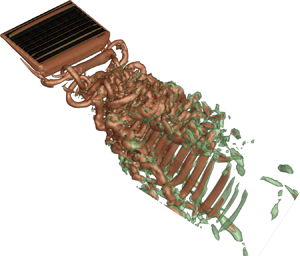Article contents
Dependence of wake structure on pitching frequency behind a thin panel at  $Re=1000$
$Re=1000$
Published online by Cambridge University Press: 12 August 2021
Abstract

We perform computations of wake transition behind a pitching panel using an immersed boundary-based method. At a Reynolds number  $Re=1000$, simulations are carried out over a wide range of pitching frequencies in the Strouhal number (
$Re=1000$, simulations are carried out over a wide range of pitching frequencies in the Strouhal number ( $St$) range
$St$) range  $0.2\leqslant St \leqslant 2$, for two different aspect ratio panels, given by 0.54 and 2.38. Our results reveal appearances of a reverse von Kármán vortex street at a moderate pitching frequency, which bifurcates into two distinct branches connected by strands at higher Strouhal number. In addition, the larger-aspect-ratio panel exhibits an avalanche of large, tangled three-dimensional vortex structures for
$0.2\leqslant St \leqslant 2$, for two different aspect ratio panels, given by 0.54 and 2.38. Our results reveal appearances of a reverse von Kármán vortex street at a moderate pitching frequency, which bifurcates into two distinct branches connected by strands at higher Strouhal number. In addition, the larger-aspect-ratio panel exhibits an avalanche of large, tangled three-dimensional vortex structures for  $St\geqslant 1.5$. We observe strong spanwise wake compression, for the larger-aspect-ratio panel, greatly influencing the secondary instabilities at increased pitching frequency. However, no direct relationship between the growth of secondary instabilities and the spanwise pressure gradient can be established. We show that an increase in
$St\geqslant 1.5$. We observe strong spanwise wake compression, for the larger-aspect-ratio panel, greatly influencing the secondary instabilities at increased pitching frequency. However, no direct relationship between the growth of secondary instabilities and the spanwise pressure gradient can be established. We show that an increase in  $St$ leads to a stable central region and renders a larger concentration of small-scale structures at the jet plane. The continuous wavelet transform shows complete synchronisation of the shed structure with the pitching Strouhal number of the low-aspect-ratio panel. The spectral characteristic for the high-aspect-ratio panel at
$St$ leads to a stable central region and renders a larger concentration of small-scale structures at the jet plane. The continuous wavelet transform shows complete synchronisation of the shed structure with the pitching Strouhal number of the low-aspect-ratio panel. The spectral characteristic for the high-aspect-ratio panel at  $St=1$ is found to be dominated by a narrow band of low-frequency cells. We observed the period-doubling phenomena in the spanwise cells during space–time reconstruction of the velocity signals. For the present ranges of
$St=1$ is found to be dominated by a narrow band of low-frequency cells. We observed the period-doubling phenomena in the spanwise cells during space–time reconstruction of the velocity signals. For the present ranges of  $St$, both thrust and lift signals reveal a constant amplitude oscillation, the latter being double, in magnitude, the former. Both root-mean-squared thrust and lift coefficients grow with
$St$, both thrust and lift signals reveal a constant amplitude oscillation, the latter being double, in magnitude, the former. Both root-mean-squared thrust and lift coefficients grow with  $St$ and aspect ratio.
$St$ and aspect ratio.
- Type
- JFM Papers
- Information
- Copyright
- © The Author(s), 2021. Published by Cambridge University Press
References
REFERENCES
- 21
- Cited by




